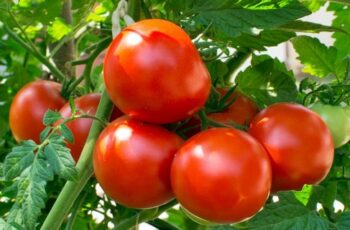Ad Blocker Detected
Our website is made possible by displaying online advertisements to our visitors. Please consider supporting us by disabling your ad blocker.
Growing tomatoes in pots is almost always an adventure. It can be incredibly rewarding or completely frustrating.
Sometimes epic failure can happen for reasons beyond your control, like a locust attack or an infestation of Tuta Absolute, or a ridiculously wet or cold summer.
But there are some common mistakes (trust me, I’ve made them all, more than once) that if you can avoid, you will greatly increase your chances of growing tomatoes in containers successfully.
1/small containers
When it comes to growing potted tomatoes, bigger is better. The larger your container, the more soil it will hold.
The more land you have, the better the soil will hold water. Also, the more soil you have, the more nutrients available to your plants.
Water and nutrient availability are two of the most critical elements for your tomato plants to grow happy, and healthy and consequently have great harvests.
2/Too much water
Properly watering tomato plants is probably the main key to tomato success. Too much water will cause the roots to rot, and too little leads to the flowers withering.
Inconsistent watering will also lead to blossom end rot, cracked tomatoes, and stressed plants.
So here’s one critical thing you must do for tomato success (and more difficult if you don’t use drip irrigation): You must keep the potting soil constantly moist, but not waterlogged, just moist.
Before watering, check if the soil is already moist. To do this, bury your index finger halfway deep and add water only if the soil feels dry to the touch.
Don’t forget the drainage too. Make sure your pot has large holes in the bottom so excess water can drain.
Raising the pot from the ground is also a good idea if you have your pot on the ground or on a non-porous surface.
Add water until the bottom of your pot drains. This way you will know that all the roots, even the ones at the bottom of the pot, have been watered.
However, the best is automatic drip irrigation. In this video, I show you a very economical and very easy-to-install irrigation programmer
3/too little water
How much water your tomato plant needs will depend on a few things, including the weather. Wind, heat, humidity, the size of the pot, and the type of potting soil you use will affect how often you need water.
In the middle of the season, a large tomato plant may need to be watered at least once a day, sometimes twice.
Also, when you water, make sure to really soak your plants; if you only give them a sip, the water will only moisten the top layer of soil.
When you water, try to water the soil directly, not the leaves, as wet leaves can cause fungus.
3/Overpopulation
Putting a lot of plants in one pot might seem like a good idea, but it’s usually counterproductive. Unless you have a tremendous pot (more like a raised bed) only put one tomato plant per pot. To get an idea of the minimum size, consider 20-liter paint buckets
4/not enough sun
Tomatoes love the sun and need full sun, which means they need direct, unobstructed sunlight for 6-8 hours a day.
Do not cheat! Many people (me included) chronically overestimate the amount of sun an area receives.
It is important that you check this, with a watch, before planting your pots.
Also, the shade in one spot can change dramatically during the growing season, so check every week to make sure there are no obstructions blocking the sun.
5/The temperature is not enough
Along with the sun, tomatoes like warm temperatures.
While it may seem like you’re getting ahead of the season by getting your tomatoes out early, nothing really will happen until it’s warm.
If you want to get ahead of the season, you can cover your tomatoes with nylon when it’s cold or do what I usually do which is transport them in and out of my house.
Until the temperatures warm up. Also, don’t forget to acclimate your seedlings once you finally get them out in the sun.
6/inverted tomatoes
Many people swear that they can grow tomatoes upside down. I do not. I’ve tried several ways and haven’t found any that are good. I can understand the point of growing hanging tomatoes, but not the other way around.
7/Tutoring too late
This is one of my most common mistakes. I always forget how fast tomatoes grow and we don’t stake them until they are huge and unwieldy.
It is much better to plant the stakes before the tomatoes get too big.
More Mistakes that you must avoid when planting tomatoes in general
1. Planting Tomatoes Too Early
Planting tomatoes too early can be problematic as these summer crops thrive in warm temperatures and do not tolerate cold weather. For optimal growth, it’s important to wait until the soil temperature reaches a minimum of 60 degrees Fahrenheit during the day, and young plants should ideally reach a height of 6 to 8 inches before transplanting.
It’s crucial not to rush the planting process as premature planting may lead to blossom drop, where the flowers fall off before the fruits can form. Additionally, if the temperature drops too low at night, the tomatoes may become misshapen, puckered, or scarred at the blossom end. However, even if the crops appear distorted, they are still safe to eat, and many beloved tomato varieties are not perfectly round or red.
2. Planting Tomatoes in the Wrong Location
When it comes to planting tomatoes, it’s important to select the right location. Although these plants thrive in warm temperatures, their soil should be kept cool and moist to avoid diseases. To prevent dried-out soil and plants, it’s best to avoid planting tomatoes in areas where potatoes or peppers have grown in the past couple of years.
To ensure optimal growth, choose a relatively open spot on your plot that receives at least eight hours of sunlight per day and has well-drained soil. Consider mulching your tomato plants to retain moisture and prevent evaporation. By layering mulch 2 to 4 inches deep around the plant, you can control weeds, prevent disease spread, and allow water to penetrate deeply into the roots.
When applying the mulch, be sure to pull the layer back about 2 inches from around the stem of the plant to form a small well around the base. This helps to prevent moisture from accumulating around the stem and causing rot or other issues.

